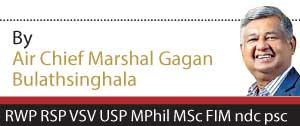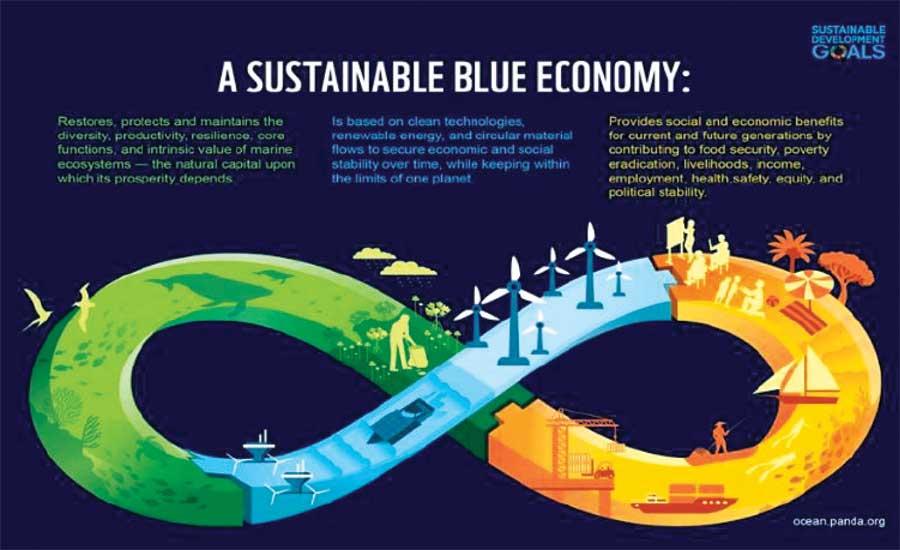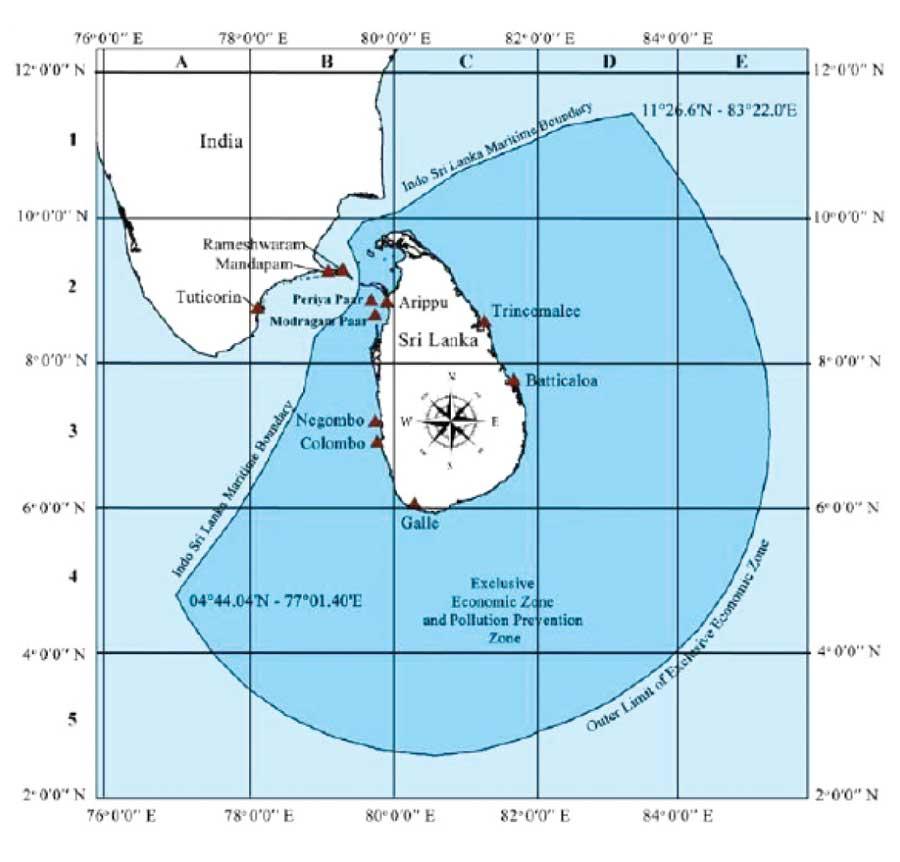25 Oct 2023 - {{hitsCtrl.values.hits}}
Strategic Importance of the Indo-Pacific in the context of Blue Economy and the need for regional cooperation: A Sri Lankan Perspective

Let me gently remind all of you that this theme merely does not reflect the immediate considerations of the current situation of the maritime domain in Sri Lanka entirely but it does look beyond, towards a broadened concept at a strategic level.
situation of the maritime domain in Sri Lanka entirely but it does look beyond, towards a broadened concept at a strategic level.
Moving on to a more appropriate note, the Indian Ocean covers almost 20% of the world’s ocean area and connects the shores of three continents.
The region consists of 36 countries, except Australia, all developing economies, and has undoubtedly dominated the economic and political affairs of the region since ancient history. The obvious reason for this is the vast amount of natural resources and availability of major energy lifelines at present. Hence, any minor turmoil within this region can cause major changes in the security and geopolitical architecture of the nations around.
Further, Sri Lanka’s geographical location which stands closer to some of the world’s most important Sea Lines of Communication (SLOC) enhances the need to facilitate and maintain a tighter and stronger maritime security domain as an island nation with a hub port.
On the other hand, let alone the whole Indian Ocean region, Sri Lanka possesses a territorial sea of 21,500 Km2 and an EEZ of 51,700 Km2 up to 200 Nm from the coastal line where the total land area of the island remains only 65610 Km2. The delimitation of the continental shelf (DECOM,) as provided in the United Nations Convention on the Law of the Sea (UNCLOS), was initiated in 1999 by Sri Lanka and was completed in 2009.
This unique feature spans an area of 3,000 Km in length and 830 to 1430 Km in width. Sri Lanka’s claim of the extended continental shelf is about 20 times its land area. This is indeed a huge area for a small country like Sri Lanka. Conducting surveillance, scientific research, infrastructure expansion etc. are among the many important aspects that Sri Lanka will need to look through a broader maritime strategic plan. Interest in the potential of the blue economy is growing, but for many financial institutions, regardless of focus, size or breadth, oceans and marine ecosystems are uncharted territory.

What is the blue economy strategy?
The World Bank defines the blue economy as the sustainable use of ocean resources for economic growth, improved livelihoods, jobs, and ocean ecosystem health. A sustainable blue economy seeks to promote economic growth and preserve and improve livelihoods across a range of sectors while ensuring the sustainable use of marine resources.
What is the biggest difference between green and blue economy?
Green economy strategies tend to focus on the sectors of energy, transport, agriculture and forestry, while the blue economy focuses on fisheries sectors and marine and coastal resources. Both incorporate strategies to address climate mitigation and adaptation.
Building a Sustainable Blue Economy
A sustainable blue economy seeks to promote economic growth and preserve and improve livelihoods across a range of sectors while ensuring the sustainable use of marine resources. Its growth is driven by investments that reduce carbon emissions and pollution, enhance energy efficiency, harness the power of natural capital, and halt the loss of biodiversity and the benefits that these ecosystems provide.
By considering lending and insurance practices that take into account the health of our oceans, financial institutions can help preserve the lives and economies that depend upon them. They can also profit from investing in protecting these precious resources and promoting sustainable marine industries. To help guide the role that banks, insurers and investors can play, the Sustainable Blue Economy Finance Principles have been created. The principles provide a guiding framework for financing a sustainable ocean economy.
What are the main components of the blue economy?
The blue economy has diverse components, including established traditional ocean industries such as fisheries, tourism, and maritime transport, but also new and emerging activities, such as offshore renewable energy, aquaculture, seabed extractive activities, marine biotechnology and bioprospecting. Bioprospecting (also known as biodiversity prospecting) is the exploration of natural sources for biochemical and genetic information that could be developed into commercially valuable products for the agricultural, aquaculture, or pharmaceutical industries.
What is the blue economy strategy?
The World Bank defines the blue economy as the sustainable use of ocean resources for economic growth, improved livelihoods and jobs, and ocean ecosystem health.
Who benefits from the blue economy?
“The blue economy” can create jobs, spur economic growth, mitigate the impacts of climate change and help meet the food needs of a growing global population. Further five crucial areas where the G20 would benefit from investing in the ocean such as; Maritime renewable energy sources, decarbonizing global shipping, urgent protection of Coastal wetlands and ecosystems, investing in sustainable fisheries, and Sustainable and regenerative tourism.
Building a blue economy
It is possible to enhance livelihoods and boost economic growth in Sri Lanka’s coastal belt without harming the environment. The fisheries sector, for example, could be optimized and expanded in many ways.
Currently, 50-60% of the overall harvest is discarded every year as trash fish, fishery waste, crab shells, or shrimp and shellfish waste, with fishers dumping it into lagoons, or the ocean. This waste could be collected and turned into value-added products, for example, animal feed, fertilizer, fish oil, and more.
Other opportunities to enhance sustainable coastal livelihoods include seaweed farming, which offers considerable co-benefits in climate change mitigation and pollution clean-up; captive breeding and Mari culture to replenish fish populations; conservation and use of coastal ecosystems such as mangroves; or scaling up sustainable nature tourism and ecotourism. Awareness creation, capacity-building, provision of expertise and technology, integrated coastal zone management, circular economy, control of land-based waste and pollution, and an enabling legal framework are also crucial elements for the transformation toward a blue economy.
However, the country is also threatened by the impacts of climate change, the COVID-19 pandemic, marine pollution and the ongoing economic downtrend. Strengthening the blue economy and exploring new avenues for coastal livelihoods and sustainable development could offer a solution with powerful co-benefits and synergies for people, the environment, and economic growth.
What are the challenges of the blue economy?
The destruction of maritime ecosystems, pollution or climate change, as well as poverty or maritime insecurity caused by terrorism or piracy.
Prospects for Blue Economy in Sri Lanka

Being an island nation in the Indian Ocean, adopting a Blue Economy strategy is not optional but mandatory for Sri Lanka. Sri Lanka has advantages but also faces challenges due to its position. The major advantages of a Blue Economy include a unique geographical position, high accessibility to ocean resources from a lengthy coastline around the country, closeness to major sea lanes, sovereignty over a significant area of sea compared with the country’s land resources, a diverse range of coastal and marine ecosystems and a high potential for tourism and recreation industries.
The Indian Ocean hosts one of the most important global maritime routes connecting the Far East with Europe and carries the majority of the ultra-large containerships. The Ocean’s maritime routes are pivotal for the worldwide supply of energy. It is estimated that almost 40% of the energy supply is transported from the Persian Gulf to Europe and Asia through its waterways.
However, these opportunities also have challenges tagged along with them. The ocean around the country is highly contested by global powers and being a small player in a global political arena, Sri Lanka has to take a cautious path.
The Government of Sri Lanka (GOSL) promoted a Blue Economy initiative under the ‘Sri Lanka NEXT’ program way back in October 2016. In addition, the country aspires to become a maritime hub in the region, taking advantage of its central geographical position and the closeness to major sea lanes. There were some steps taken in this direction, with mixed results. Our country has been promoting its image as a tourism destination, with unique marine and coastal attractions, with some success. Despite these ad hoc efforts, however, Sri Lanka is yet to come up with a viable Blue Economy strategy that combines the strength of these efforts.
Although, the current maritime situation of Sri Lankan territory overall appears politically peaceful and stable despite few occurrences related to poaching in North Western seas; which the GOSL is making every effort to sort the matters diplomatically, existing transnational security threats keep re-emerging at a substantial level. Maritime piracy, drugs/arms smuggling, human, trafficking, unregulated fishing activities and other transnational crimes have become more and more prominent airing a non-traditional security threat.
Since 2007, maritime piracy has caused a significant disruption incurring huge losses to the global sea trade. Due to the unstable condition in Somalia, pirate attacks have increased in the past on the high seas of the Western Indian Ocean and Mozambique Channel.
After more than a decade of effective threat-reducing counter-piracy operations, the shipping industry has removed the ‘Indian Ocean High-Risk Area’ (HRA). Notification of the removal of the HRA from 0001 UTC on 1 January 2023 by industry bodies has been affected.
The removal of the HRA reflects a significantly improved piracy situation in the region, largely due to concerted counter-piracy efforts by many regional and international stakeholders. However, drug and arms smuggling is considered to be a critical danger to the present maritime security. The aforementioned means are believed to be the most profitable illegal businesses where the money earned is used to finance various terror networks at a global scale.
At the national level, drug trafficking and arms smuggling can influence nations’ stability and
trigger interstate conflicts within the region as both means are directly linked with each other. On
the contrary, a country’s EEZ exerts sovereign rights for a state to explore, exploit and conserve natural resources within its boundaries. In this regard, the Sri Lankan EEZ contains a huge amount of explored and unexplored natural resources such as fisheries, minerals and natural gases; if harnessed, which are of utmost value to the nation-building efforts.
On a strategic note, ensuring security within our EEZ possesses direct impacts towards the development of our region.
To remind you again, the responsible marine area is almost 9 times the size of the land area of my country Sri Lanka. Considerately, the future prosperity of Sri Lanka lies in the sea which surrounds it. The rich marine biological, chemical and physical resources in Sri Lankan EEZ coupled with its strategic location in the Indian Ocean provide us with promising expectations of development as a recuperating nation in the Indo-Pacific in the context of a Blue Economy.
On a basic analysis, one can argue that to attain a higher degree of dominance over our EEZ which becomes more of a responsibility if expanded, it might be unattainable in the future due to lack of assets. Nevertheless, the lack of resources to face challenges has never been an obstacle for Sri Lanka which is capable of developing out-of-the-box strategies to overcome challenges. Let alone the interoperability between the armed forces in Sri Lanka, but robust relationships and cooperation amongst relevant authorities of other regional nations also play a critical role in this voyage.
The World Bank defines the blue economy as the sustainable use of ocean resources for economic growth, improved livelihoods, jobs, and ocean ecosystem health. A sustainable blue economy seeks to promote economic growth and preserve and improve livelihoods across a range of sectors while ensuring the sustainable use of marine resources
In 2011, around 86% of Lanka’s fish supply came from the sea. In addition, the recent exploration of oil and gas reserves could easily open a host of new economic opportunities.
However, these opportunities also have challenges attached to them. The oceans around the country are highly contested by global powers and being a small player in a global political arena, Sri Lanka has to take a cautious path. The Government of Sri Lanka promoted a Blue Economy initiative under the ‘Sri Lanka NEXT’ program in October 2016 which was a timely effort. There were some steps taken in this direction, with mixed results. The country has been promoting its image as a tourism destination, with unique marine and coastal attractions, with some success.
Despite these ad hoc efforts, Sri Lanka is yet to come up with a viable Blue Economy strategy that combines the strengths of these efforts. As per the available statistics share of the blue economy as a percentage of GDP is 9.4%. (source Kumara 2017 Blue economy: Prospects and challenges for Sri Lanka BCIS Signature Seminar.)
“The geopolitics of the Indian Ocean has unfortunately made us the punching bag for Hambantota. President Ranil Wickremesinghe addressing the first batch of graduates of Sri Lanka’s National Defense College on September 15, made significant points: Firstly, Sri Lanka has unfortunately become a “punching bag” because of Hambantota port although that port is only one of the 17 Chinese ports in this region and is only a commercial port. Secondly, he assured New Delhi that Sri Lanka will not compromise on India’s security interests and will always work together with it to ensure the security of the region. Further, some more ports are operated by Dubai World ports. Now, all the ports are commercial ports. So is Hambantota. It is not a military port,” the President stressed.
“If there is security significance, it is in the port of Darwin in Australia where you have, as they say, Chinese ports operating side by side in the area which the Australian and the US forces use for training. We don’t have that. We don’t allow anyone to come and train here, but we do have our southern command of the navy. We have a divisional headquarters of the army and we have a detachment of the Air Force. They only ensure that this is a commercial port.”
“So, though we are a commercial port, it shows our strategic importance that many people come to unwarranted conclusions. And I hope the next agreement we come to with China, will not cause such speculation. It is only about debt reduction for Sri Lanka,” President Wickremesinghe assured.
CONCLUSION
The blue economy and its sustainability have emerged as one of the key research issues in recent decades and have become a buzzword among policymakers in this field. Although a reasonable number of studies have made attempts to assess the blue economy from different perspectives, to the best of our knowledge no study has empirically examined the factors that drive the size of the blue economy.
The role of ocean governance is often described as an important factor behind blue economy activity. It has further revealed the importance of more investment in the fisheries and agricultural sector, better access to electricity, and better export opportunities as the major determinants of fisheries output. The research further revealed that world income, relative price, depreciation in the nominal exchange rate between the domestic currency and the US dollar, along with policy and financial crisis dummies positively affect the size of the tourism sector. Thus, the size of the blue economy has positively responded to these sustainable ocean management policies.
In addition, the need for, and effectiveness of, the implementation of sustainable ocean governance policies in the Asia and Pacific island region, can further strengthen the growth of these island countries. Sri Lanka has the potential to implement the concept of a blue economy, through the usage of our resources. A better understanding of the ocean and its dynamics, selection of suitable individuals, carefully considered decisions, as well as honest political leadership are all needed to execute such a program accurately and efficiently.
(This was presented at the India, Island States, and the Indo-Pacific-Towards a Sustainable Blue Economy, Inaugural edition of The Indo-Pacific Confluence Dialog 2023, 11th January 2023 The Peninsular Foundation, Chennai India. www.thepeninsula.org.in/indo-pacific- confluence-dialogue.)
The writer is formerly Commander Sri Lanka Air Force, Ambassador to Afghanistan President Association of Retired Flag Rank Officers

26 Dec 2024 44 minute ago
26 Dec 2024 2 hours ago
26 Dec 2024 2 hours ago
26 Dec 2024 3 hours ago
26 Dec 2024 3 hours ago